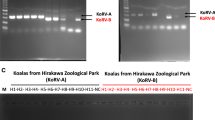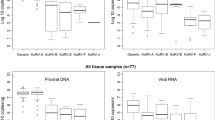Abstract
Koala retrovirus (KoRV) is a gammaretrovirus that is becoming endogenous in koalas. Here, we explored the dynamics of KoRV infection in captive koalas in Japan. We isolated peripheral blood mononuclear cells (PBMCs) from 11 koalas, from which we extracted the KoRV genome. We found the prevalence of KoRV provirus in the koalas to be 100%, and the copy number of KoRV proviral DNA in genomic DNA isolated from PBMCs was variable. The KoRV envelope genes from 11 koalas were sequenced and all were found to be KoRV type A. Nucleotide substitution analysis revealed differences in the KoRV env gene sequences of parents and their offspring. Although no viral KoRV RNA was detected in plasma of healthy koalas, a high copy number was found in plasma of a diseased koala (#6). Hematological analysis showed a high white blood cell (WBC) count in the blood of koala #6. Notably, when retested ~ 5 months later, koala #6 was found to be negative for KoRV in plasma, and the WBC count was within the normal range. Therefore, KoRV in the plasma could be a possible indicator of koala health. We also investigated KoRV growth in concanavalin-A-stimulated koala PBMCs by measuring the KoRV provirus copy number in gDNA and the KoRV RNA copy number in cells and culture supernatants by real-time PCR at days 4, 7, and 14 post-culture. We also observed that KoRV isolates were able to infect HEK293T cells. These findings could enhance our understanding of the dynamics of KoRV and its pathogenesis in koalas.





Similar content being viewed by others
References
Rasmussen HB (1997) Interactions between exogenous and endogenous retroviruses. J Biomed Sci 4:1–8
Gifford R, Tristem M (2003) The evolution, distribution and diversity of endogenous retroviruses. Virus Genes 26:291–315
Bock M, Stoye JP (2000) Endogenous retroviruses and the human germline. Curr Opin Genet Dev 10:651–655
Boeke JD, Stoye JP (1997) Retrotransposons, endogenous retroviruses, and the evolution of retroelements. In: Coffin JM, Hughes SH, Varmus HE (eds) Retroviruses. Cold Spring Harbor, Cold Spring Harbor Laboratory, New York, pp 343–346
Hanger JJ, Bromham LD, McKee JJ, O’Brien TM, Robinson WF (2000) The nucleotide sequence of Koala (Phascolactos cinereus) retrovirus: a novel type C endogenous virus related to Gibbon ape leukemia virus. J Virol 74:4264–4272
Tarlinton R, Meers J, Hanger J, Young P (2005) Real-time reverse transcriptase PCR for the endogenous koala retrovirus reveals an association between plasma viral load and neoplastic disease in koalas. J Gen Virol 86:783–787
Denner J, Young PR (2013) Koala retroviruses: characterization and impact on the life of koalas. Retrovirology 10:108
Chaban B, Ong VA, Hanger J, Timms P (2017) Molecular dynamics and mode of transmission of Koala Retrovirus (KoRV) as it invades and spreads through a wild Queensland koala population. J Virol. https://doi.org/10.1128/JVI.01871-17
Simmons GS, Young PR, Hanger JJ, Jones K, Clarke D, McKee JJ, Meers J (2012) Prevalence of koala retrovirus in geographically diverse populations in Australia. Aust Vet J 90:404–409
Kinney ME, Pye GW (2016) Koala retrovirus: a review. J Zoo Wildl Med 47:387–396
Shaw G, Morse S, Ararat M, Graham FL (2002) Preferential transformation of human neuronal cells by human adenoviruses and the origin of HEK 293 cells. FASEB J 16:869–871
Miyazawa T, Shojima T, Yoshikawa R, Ohata T (2011) Isolation of koala retroviruses from koalas in Japan. J Vet Med Sci 73:65–70
Tarlinton R, Meers J, Young P (2006) Retroviral invasion of the koala genome. Nature 422:79–81
Kumar S, Stecher G, Tamura K (2016) MEGA7: molecular evolutionary genetics analysis version 7.0 for bigger datasets. Mol Biol Evol 33:1870–1874
Xu W, Gorman K, Santiago JC, Kluska K, Eiden MV (2015) Genetic diversity of koala retroviral envelopes. Viruses 7:1258–1270
Shojima T, Hoshino S, Abe M, Yasuda J, Shogen H, Kobayashi T, Miyazawa T (2013) Construction and characterization of an infectious molecular clone of koala retrovirus. J Virol 87:5081–5088
Nitta T, Ha D, Galvez F, Miyazawa T, Fan H (2015) Human and murine APOBEC3s restrict replication of koala retrovirus by different mechanisms. Retrovirology 12:68
Funding
This work was supported by grants from the Ministry of Education, Science, and Culture, Japan.
Author information
Authors and Affiliations
Corresponding author
Ethics declarations
Conflict of interest
The authors declare that they have no competing financial interests.
Ethical approval
This study was done in accordance with institutional committee protocols.
Additional information
Handling Editor: Wu Li.
Publisher's Note
Springer Nature remains neutral with regard to jurisdictional claims in published maps and institutional affiliations.
Electronic supplementary material
Below is the link to the electronic supplementary material.
Fig. S1
Multiple sequence alignment of partial nucleotide sequences (A) and predicted protein sequences (B) of KoRV env genes isolated from 11 koalas. Specific nucleotide and amino acid changes are indicated by black and red boxes, respectively
Rights and permissions
About this article
Cite this article
Kayesh, M.E.H., Yamato, O., Rahman, M.M. et al. Molecular dynamics of koala retrovirus infection in captive koalas in Japan. Arch Virol 164, 757–765 (2019). https://doi.org/10.1007/s00705-019-04149-5
Received:
Accepted:
Published:
Issue Date:
DOI: https://doi.org/10.1007/s00705-019-04149-5




